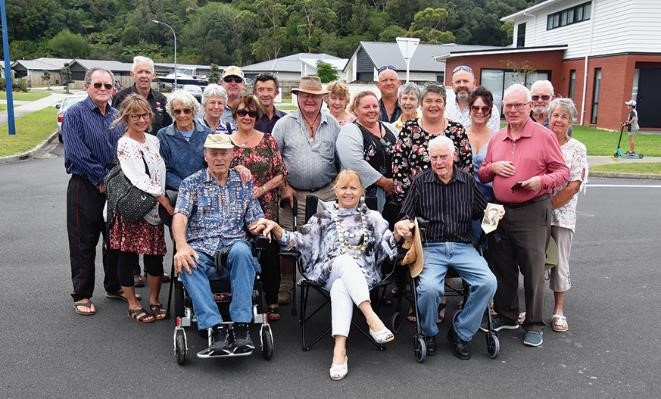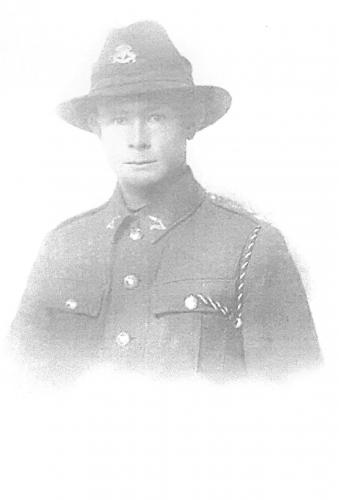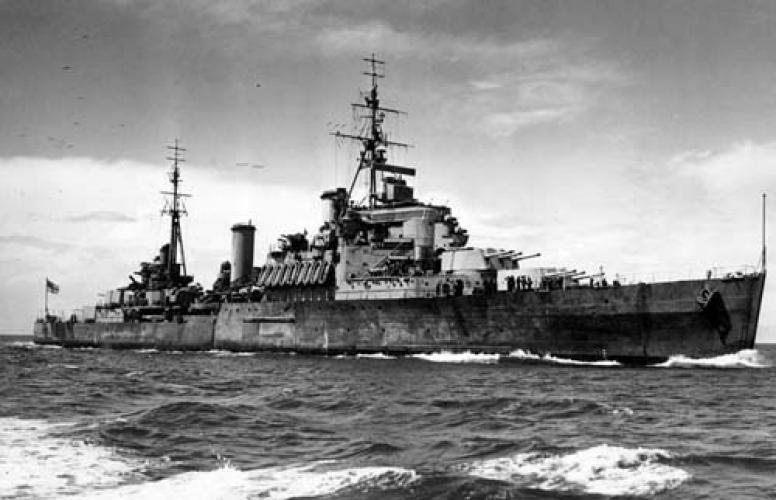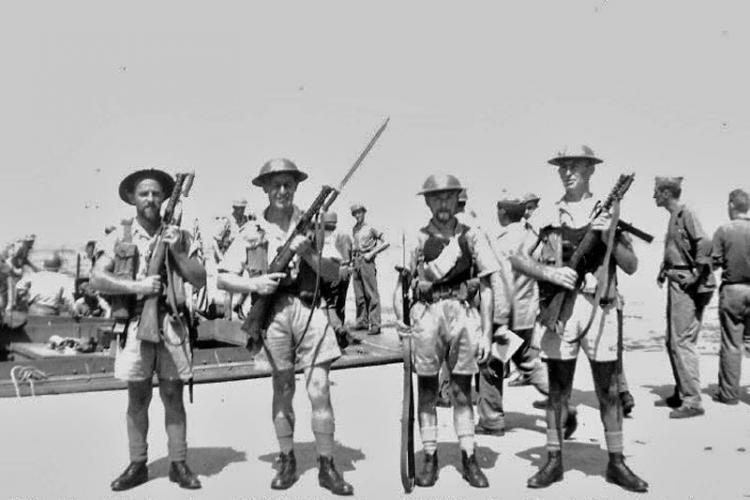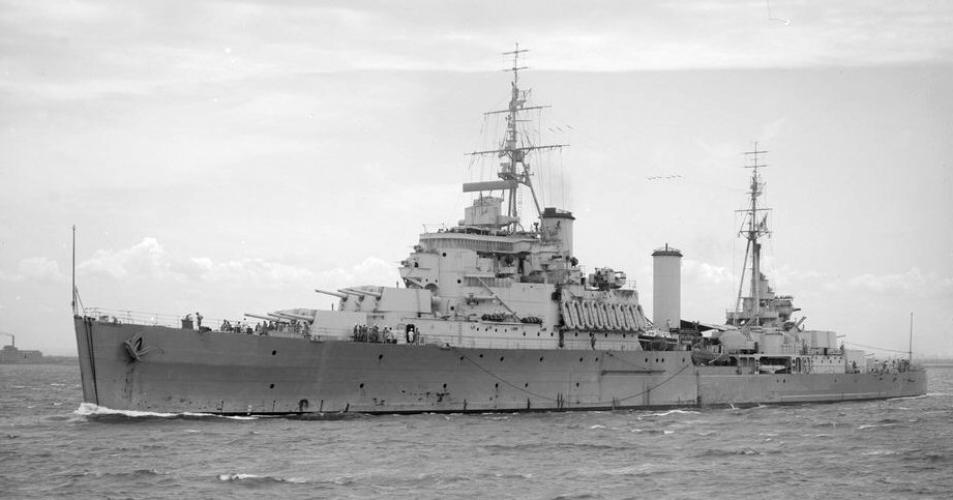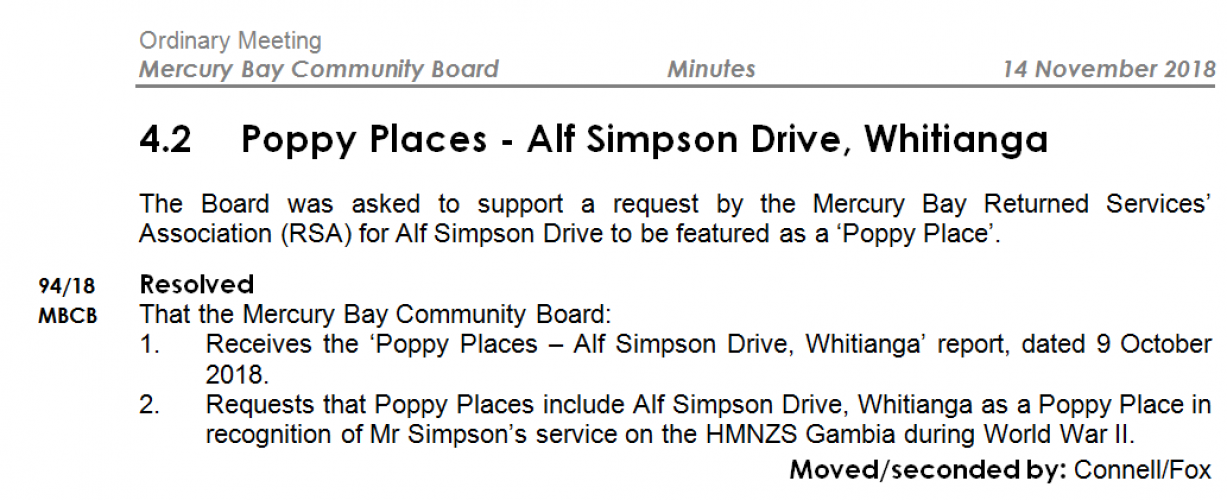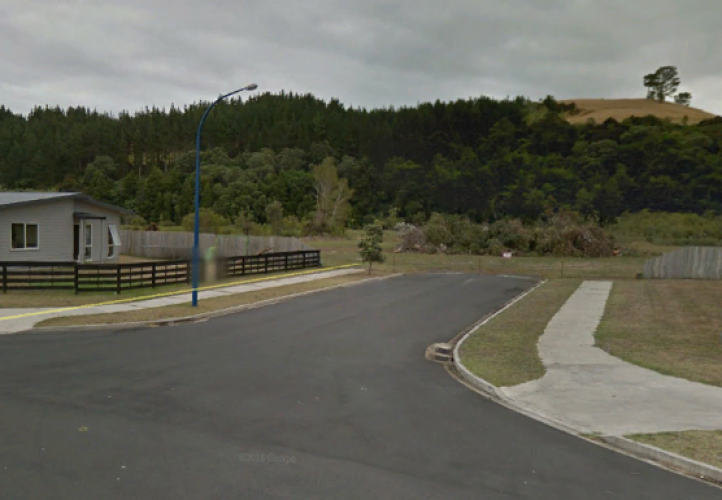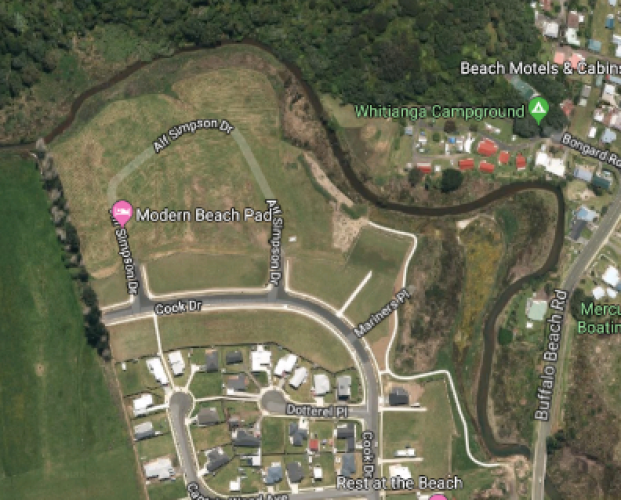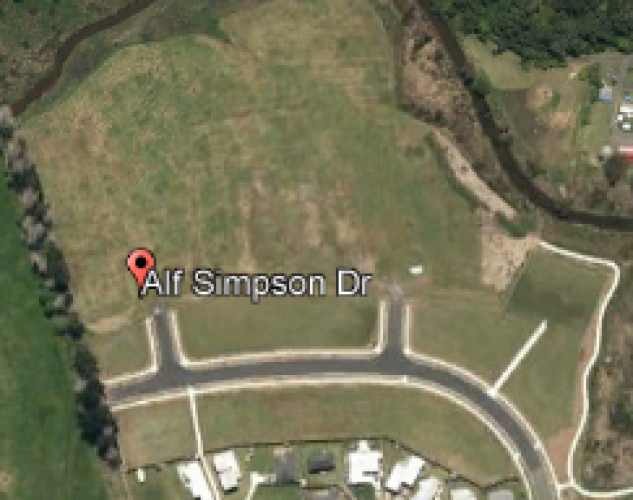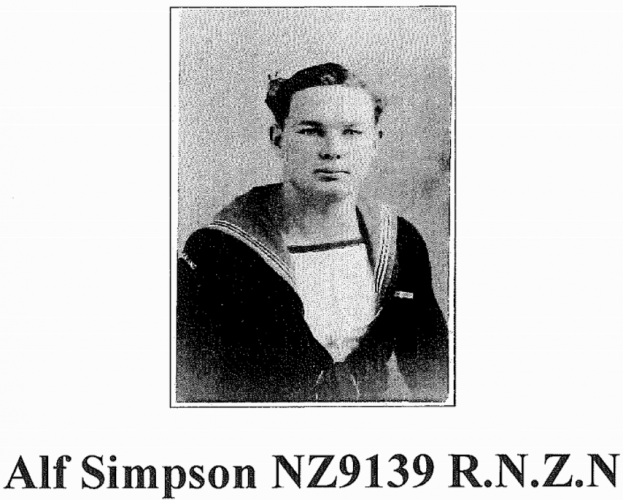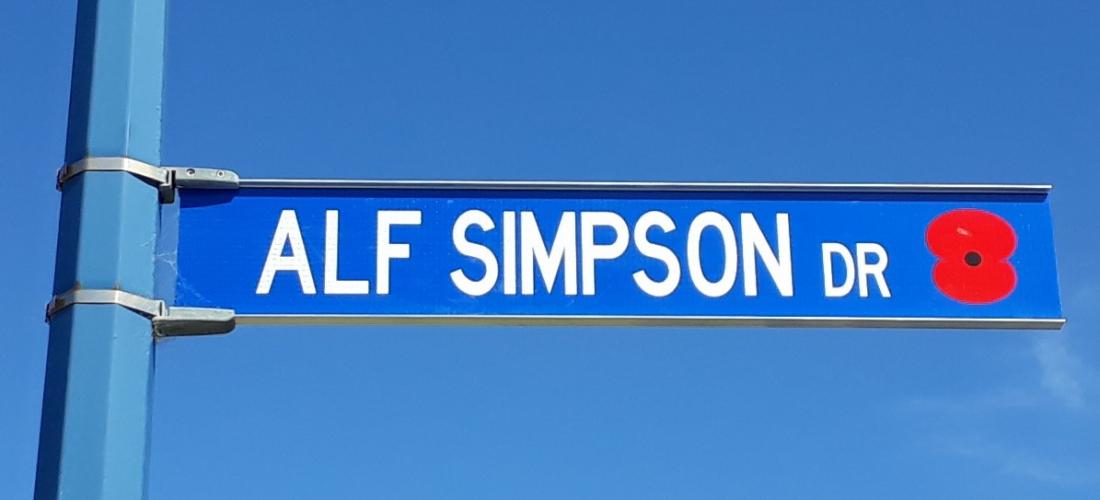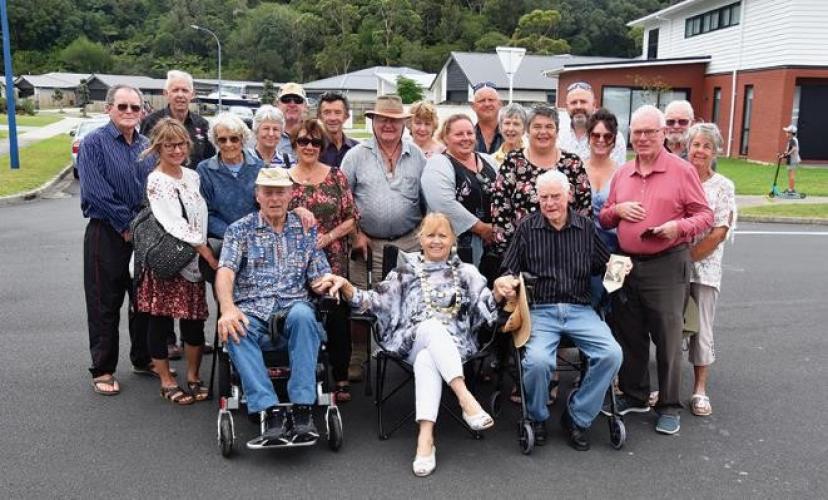179 Alf Simpson Drive
Reason for the name
This new street in Whitianga is named in honour of Alf Simpson’s service in WWII on HMNZS Gambia.
This place was named in memory of Alf Simpson’s service in WWII on HMNZS Gambia as per the Mercury Bay Community Board resolution of 14 November 2018. See the gallery for a copy of the Board's resolution. Alf Simpson Drive is located at the northern end of Cook Drive Whitianga in what is known as the Pacific Estate subdivision.
HMS Gambia was a Crown Colony-class light cruiser of the Royal Navy. She was in the service of the Royal New Zealand Navy as HMNZS Gambia from 1943 to 1946. She was named after the then Crown colony of Gambia, and has been the only ship of the Royal Navy to bear the name.
Authors: Heather Bruce (Thames-Coromandel District Council) Max Thomas (Mercury Bay RSA) Sherri Simpson (Alf Simpson’s daughter)
Like his father, Richard (Alf) Alfred Simpson who joined the Army and served in France in World War 1, Alfred Alexander Simpson made the decision to join the armed forces to serve his country during a time of war. Alfred (Alf) Alexander Simpson applied to join the Navy in 1943 and has written his story which follows here:
NZ9139 A.A. Simpson RNZN This is my story as a crew member of HMNZS Gambia 1944 to 1946
During World War 11 the Royal New Zealand Navy, every six months, called for volunteers between the ages of 15yrs 3months and 16yrs 9 months, to join the Navy. They were known as a Seaman Boys class. I applied in December 1943 to join the Navy, reporting to the naval base in Auckland for an interview and medical examination, along with some forty to fifty others in this age group from throughout New Zealand.
In early January 1944 thirty six of us received a call up to report to the naval base on the 3rd of Feb 1944. On arrival we boarded a launch and were taken down harbour to Motuihe Island, where we did our basic training, which included learning to splice ropes, tie knots, flag signalling, small boat handling, rowing and parade ground drill with rifles and bayonet practice, also boxing and a lot of physical exercises. Training completed we were drafted back to Auckland. Our first experience of life at sea was on a minesweeper.
In those days all shipping coming out of Auckland came down the Hauraki Gulf inside the Barrier, Great Mercury and Ohinau Island. It was in this area where the Germans and Japanese earlier in the war laid their mines. The odd ones were still being located and exploded by small arms fire. Living in Kuaotunu, before I joined the Navy we occasionally heard the explosive blast, when they came ashore, probably on one of the Islands. Mines were also laid further up the Northland coast.
In June 1940 the liner Niagara struck a mine laid only about a week earlier by a German submarine and sank with two and half million pounds worth of Gold Bullion on board, fortunately with no loss of life. Around that time three other large ships with passenger and general cargo from New Zealand were sunk by German raiders Komet and Orion with some loss of life.
Everyone today going out boating and fishing in this beautiful greater Mercury Bay area of ours should know that the enemy was right in our back yard at that time during the war and that it could have been so very different to-day. Had the Japanese landed and occupied New Zealand with something like Dads Army as the only thing we had to defend ourselves with, as our army was in the Middle East at that time. At that time thank God for the might of America, as we witnessed and were involved in the next twelve months in the Japanese back yard, until the end of World War 11.
We were all fortunate when the Americans broke the Japanese code and were able to locate the Japanese invasion fleet coming south near the Solomon's and sinking or damaging a large number of their carriers and warships. At that time the two New Zealand cruisers taking part were both put out of action; Achilles by a bomb, and the Leander more severely by a Torpedo and took no further part in the war. Following our brief minesweeping experience it was back to shore base in Auckland late September.
On our return to Auckland it was decided that our class and a total of just over 200 Naval personnel were required to join the new replacement cruiser HMNZS Gambia based in the Indian Ocean at Trincomalee Naval Base in Ceylon, now known as Sri Lanka. So this was to be the start of our great adventure.
Travelling by overnight train from Auckland to Wellington, we arrived in the early morning alongside the troop ship Denota Castle (certainly no cruise liner). We boarded the ship and found ourselves mixed up with Army personnel, possibly a couple of thousand re-enforcements on their way to the war in Italy, where New Zealand at that time, was heavily involved.
We were only to stay on this ship for one night, as the next morning the Army personnel decided the ship was overcrowded and walked off. Unfortunately for the naval personnel, we were disembarked and reluctantly taken back to Auckland where we were required to wait for the Gambia's arrival in New Zealand.
On the 8th November 1944 the Gambia sailed into Auckland, going straight into dry dock for maintenance where she remained until late January 1945. Our class was on board the Gambia during this time, learning about our new ship.
Maintenance completed it then was out into the Hauraki Gulf to do our sea trials, part of which included achieving maximum speed. Using full power from 72,500 ship horse power, turning four props we hit a top speed of 33 knots, equivalent to 61.1 km/hr. At this speed standing on the quarter deck of a 10,000 ton warship was a spectacular site charging along dragging her stem through the water appearing to be below the boiling foaming surrounding sea.
Sea trials over, the Gambia sailed down to the South Island on the 27th January 1945 to allow residents of Dunedin and Christchurch a look over New Zealand's newest warship, arriving back in Auckland on the 4th of February.
The next day the battleship HMS Howe, cruiser HMNZS Achilles and three Australian destroyers arrived in Auckland. Several days later along with the Gambia this fleet of warships sailed out into the Hauraki Gulf to undertake combined exercises, which included live gun fire. A large number of fighter bombers flew out from the Hobsonville and Whenuapai Air Bases, coming in from all angles, giving us an example of what we may expect up in the Pacific war zone.
During one night the Howe and Gambia fired a number of broadsides off the Coromandel coastline out towards Little Barrier. These 14inch guns on the Howe were the largest ever fired in New Zealand and were heard loudly in Kuaotunu, where my parents were farming and all around the Auckland area. It lit up the night sky and fair shook the settlement of Waitakaruru on the Hauraki Plains. This being remembered by my future wife Dorette Perry and her Parents who lived there.
The Gambia later in the day time dropped a depth charge, used for submarine defense. The underwater explosion from this sent a huge volume of water 60ft into the air and left a massive lot of snapper and other fish floating on the surface of the water.
On the 14th Feb 1945 the Gambia sailed out of Auckland with the Howe and her three Australian destroyer escort, travelling inside the Great Mercury and Ohinau Island. On board the Gambia was our class now of only 33 and a total crew of just over 900, with me aged 16 years 5 months the youngest member of the crew.
It took four days to reach Australia. Once clear of the coast, we began the practice of sailing a zig zag course which was a normal procedure for ships during the war. This made it more difficult for submarines to line up the target, that wasn't on a straight course. Submarines were always the greatest danger anywhere at sea. Once clear of New Zealand Captain William Poulett Royal Navy addressed the Gambia crew to inform us that we would be part of the British Pacific Fleet operating in Japanese waters, where attacks by suicide planes (kamikaze pilots) were sinking or severely damaging a lot of USA ships and in preparation for this we will be constantly carrying out anti-aircraft gunnery practice with our 4 inch 40mm and 20mm close range weapons.
We arrived in Sydney a huge impressive city with a harbour full of warships of all sizes. We sailed slowly up the harbour under the bridge and tied up at the naval base. All mail now leaving the ship was censored and this remained until the end of the war making letters home difficult to write not being able to describe what was happening.
On February 1st we departed from Sydney in company with part of the British Pacific Fleet including four large aircraft carriers, two battleships and a number of smaller warships. It was a hot sunny day and blowing a gale out in open waters. It was the first really rough experience for us with carriers taking seas over their bows which were forty to fifty feet high. It remained stormy all the way up the Australian coast.
Seven days after leaving Sydney we reached Manus Naval Base in the Admiralty Islands. While there around I08 of the crew, including myself got the mumps. We were all sent onto the Hospital Ship Oxfordshire for about a week. On 22nd March, back on the Gambia, we sailed out of Manus with part of the British Pacific Fleet and joined up with a convoy of some eighty odd, ships. Antiaircraft firing practice at targets being towed by aircraft was a constant activity. Before all this live practice the whole crew were allotted an action station, where about ninety per cent of the personnel are below deck or in enclosed gun turrets.
I was given an action station on 40mm Pom-Pom guns and then later, part of a crew of a 4inch gun turret where I was able to see all of the action that involved our ship and the whole British Pacific Fleet of thirty seven warships right up to the Japanese surrender.
We arrived with the convoy at Leyte Gulf in the Philippines where hundreds of other ships were waiting to sail north into the war zone.
On the 31st March 1945 we left the Gulf of Leyte with the whole British Pacific Fleet. The Gambia being the central ship there were four large aircraft carriers around us, each about 2000 yards away and the battleships Howe and King George V steaming in front of them with six cruisers, 21 Destroyers and some smaller ships scattered around.
We headed for the Sakishima Island where the Aircraft Carrier’s planes bombed several airfields. Only one Japanese suicide plane got through our fighter plane screen and disabled the destroyer HMS Ulster with a near miss. The Gambia was instructed to tow her back to Leyte Gulf, which took three days travelling at about 8 knots and left us as a dangerous possible submarine target. This was later confirmed when we heard that the USA cruiser Indianapolis, about that time coming into the Philippines under radio silence after delivering critical parts for the atomic bomb, was sunk by a Japanese submarine and no one new for three days by which time 800 odd crew members had perished, many of them eaten alive in the shark infested waters. A book was written about this tragic event after the war, “In Harms Way” by Doug Stanton and available at most libraries.
On completion of the towing of HMS Ulster the Gambia immediately sailed from San Pedro Bay after loading a cargo of many disposable fuel tanks to be used by the carriers Seafires and Fireflys to increase their range. With the Gambia's sister ship, HMS Uganda, which had only three 6 inch gun turrets and in place of the 4th 6inch turret on the quarter deck were ml!ltiple 40mm pom-poms and all sorts of close range anti-aircraft weapons, being very handy in a suicide plane attack.
We were required back with the British Pacific Fleet as soon as possible. So with a couple of destroyers and the two cruisers steaming at a steady 28 knots we were back with the fleet within 36 hours compared with the 3 days taken by the towing job.
During the following days in mid-April we bombarded the Sakishima group of Islands and also Formosa, now called Taiwan. Closing into the cost line we fired 230 rounds of 6 inch shells, just on dawn and still quite dark. The Gambia's port side 40mm Pom-Pom guns accidentally shot down a USA Hellcat fighter, mistaken for a Japanese suicide plane. At that time I was part of the starboard Pom-Pom gun crew. Unfortunately this happened on many occasions with other ships. With a vast number of warships and planes, identification had to be made in seconds due to suicide attacks.
Around this period we were at sea for weeks at a time in the Okinawa area south of Japan, where the United States had 1200 warships of all sizes and every so often we would see this vast fleet in the mornings supporting the marines landing on Okinawa. Okinawa was required for a base in preparation for the pending invasion of the Japanese mainland.
About every ten days at sea, we would retire back from the war zone and meet up with the fleet oil tankers and supply ships for fuel and a large range of supplies. On one occasion we spent eighty five days continuously at sea following this procedure.
We did return to Leyte occasionally for rest periods. Being in the middle of summer and around 100 degrees we spent a lot of time swimming over the side. It was a Royal Marines job, to stand in a high prominent position with a loaded high powered rifle, to be used in this shark infested area on any shark sightings.
Back at sea on the 9th of May, the fleet was attacked late in the day, when our fighter planes were unable to stop all of the large number of Japanese suicide bombers. About 2km away on the starboard side of the Gambia the carrier Victorious was attacked from one plane directly above; with it exploding in the middle of the flight deck and another coming in at sea level, crashing along the length of the flight deck.
On our port side at the same time the Carrier Formidable was hit by a third plane from directly above. While this was happening, the battleship Howe steaming in front of us was firing all close range weapons at another Japanese plane coming in at the stem. In the last seconds desperate gun fire caused it to veer off and crash into the sea on her port side. A few minutes later the pilot's body attached to a small parachute, floated past our starboard side. Our official photographer on the Gambia took several photos of all this action. On board the Victorious, there were thirty four casualties including seventeen killed in that attack.
On the 26th of May the Gambia left the main fleet sailing south to Manus and on to Sydney arriving there on the 3rd of June. She went straight into dry dock for hull maintenance and other repairs.
On 28th of June we sailed out of Sydney back to Manus and North into Japanese water joining up with the British Pacific Fleet, now part of the USA third fleet. From now until the end of the war any aircraft attack would be suicidal. We were now operating some 100 to 300 miles out to the East of Tokyo, from where our carrier planes were attacking Japanese mainland targets.
Many of our planes were coming back with damage including no under carriage or only one wheel down, parts of wings missing etc. causing dangerous situations trying to land, with some ditching in the sea close by hoping to survive and be picked up. This was on going through July and early August.
On 9th of August the Gambia closed into mainland Japan around midday, in company with seven destroyers, six cruisers and three American battleships we began bombarding the Kamaishi steel works city.
A spotter plane flying above the steel works target area, sending radio messages back to the Gambia to indicate where our broadsides of 12 six inch shells were landing, this being necessary as the steel works was back behind a small mountain range. At times when the Japanese antiaircraft shells started getting close to our spotter plane it was forced to climb or dive evasively to a different altitude so as to continue radio signals of the correct range. All the warships involved had to tum together, going up and down the coast, when the maximum range of about 20,000 yards was reached. In local terms this would be equivalent to firing a broadside from the seaward side of Whale Rock exploding in any part of Whitianga town-ship some 18km away. At one stage shore gun fire started to come out from the steep cliffs on the coast, with the larger ships out of range a couple of destroyers were ordered to close in. With several broadsides from their 4 inch guns they brought down huge chunks of the cliffs which soon put an end to that threat. One Japanese plane came out and was quickly shot down with all warships having a crack at it, as it came out of the high cloud cover.
After about three hours the American Commander on one of the battleships called for a halt in the bombardment, and withdrawal from the coast line. At this time the Gambia's 6 inch guns were loaded and ready and asked for permission to fire the last broadside. That turned out to be the last shots of the Second World War as on our return back to the main fleet news came that the atomic bomb had been dropped and the war would be over soon.
My mother kept some of the letters I wrote to my parents. One of which I wrote 64 years ago said "well the war is over although we have been attacked by Japanese planes since the cease fire". Three hours after peace was declared a Japanese plane diving towards the fleet to attack us was engaged by our fighters overhead. After a few bursts from our fighters the Japanese plane blew into a hundred pieces directly overhead. Some of the pieces of the plane landed on our ship and several stray bullets also hit us, but fortunately no one was hurt. The bomb that the plane was carrying burst in the water about one hundred yards from us. The Gambia also fired at the attack plane which turned out to be the last shots in world war 11 for the second time.
On the 13th September the Gambia anchored in Wakejama Bay to become involved in the evacuation of three thousand POWs. They were loaded onto two large hospital ships and one of the British aircraft carriers. The POWs were showing signs of the starvation and cruel treatment received.
We are now part of the British and USA fleet waiting off the coast until it is declared safe to enter Tokyo Bay. During this time a fly past of over 1000 planes from the carriers took place and with an impressive show of power the vast fleet of ships manoeuvring in unison with changes of course.
On the 31st August 1945 we finally sailed into Tokyo Bay and anchored quite close to the Battleship Missouri. With binoculars we were able to see all those present on the quarter deck of the Missouri at the signing of the Japanese surrender during this historic occasion on the 2nd of September 1945.
The next day we went ashore, boarded a train which was crowded with only Japanese women and children and travelled up to Tokyo and saw the result of constant bombing. Only the odd large buildings here and there were left standing. Lots of kids were following us around and asking for chocolates and cigarettes in exchange for hands full of Japanese money in notes which we were able to use to buy the odd souvenir.
During this operation we were struck by a typhoon which started with a heavy swell. A big American cruiser close to us was rolling around spectacularly. By dusk with the wind at 90 knots it had turned the sea into a flat foaming area. A couple of hours later with the wind still increasing things were becoming dangerous and required all ships to weigh anchors and head out to sea and ride it out.
On the 11th October Gambia was relieved of her duties by HMNZS Achilles and sailed from Tokyo Bay for Manus under peace time routine which included a slower more economical speed and I must say less excitement than during the war with being continually on alert to all sorts of possible attack. We arrived 17th October at Manus for refuelling, then on to Sydney arriving 23 October, and on home to Auckland arriving 30 October 1945, having been away for seven and a half months experiencing all of the above.
The Gambia was tied up at the naval base from 30th October waiting to be returned to the British Government. We sailed out of Auckland on the 12th Feb 1946 for Sydney, with a reduced steaming, crew which included my class that had joined up on the 3rd Feb 1944 arriving back in Sydney for the fourth time in the last year.
On Victory Parade Day, 8th June, there were over twenty thousand from many different countries marching. We marched six miles through the streets of London and back to Kensington Park camp. The next day the King and Queen made an informal visit to the complete New Zealand contingent, Princesses Elizabeth, our present Queen and her sister Margaret, 17 years old, the same age as myself, were also with the Royal party.
On the 1st August 1946 after being on the Gambia a year and eight months, we New Zealanders finally left to join the 5,700 tons light cruiser Bellona, which needed only half the crew of about 980 that was required to operate the 10,000 ton Gambia. We were now based near London in the Thames Estuary. On the 24th October we sailed from England in the Bellona out into the North Sea, through the straights of Dover, down into the North Atlantic where we ran into a full blown Atlantic storm, worse than anything we had experienced before, with the Bellona rolling at times up to 45 degrees.
The next port of call was at the beautiful Island of Bermuda where all the houses were painted white, a vast contrast to the dark grey buildings in England. Upon going ashore a number of us hired push bikes and cycled our way around the Island and through the main town of Hamilton. Once off the bikes we entered the nearest pub and tried the new and most popular drink at the time: Rum and Coco Cola with a good sprinkling of ice, which went down very well in the tropical climate. The following day we sailed out into the unpredictable North Atlantic weather and during the next week passed the West Indies, Cuba and on into the Caribbean Sea towards the Panama Canal. I thought the approach through the Lakes, being lifted up from the Atlantic side then being lowered down into the Pacific Ocean was definitely one of the around the world voyages most interesting experiences to have taken part in 63 years ago.
Since then huge improvements have taken place with the modernizing of facilities and widening with more to come. November the 10th sailed from exotic Balboa on the Pacific side passing the coast line of Mexico and arriving at San Diego on the 20th November to be met by a band on the wharf welcoming us to the United States of America. Some of us were lucky to receive leave passes from 12.30 pm to 7.00 am on the 22nd, enough time to have a good look around. So we boarded a Grey Hound bus which took us up to Los Angeles, a four hour trip taking us into the third largest city in the States, beautifully lit up with millions of coloured lights, with houses and most buildings brightly painted. It was a prosperous booming peace time look with no war damage, due to not having had to defend the homeland. Prosperous to us meant everything was very expensive with a hamburger costing 80 cents, probably about a day's pay. The lady serving us remarked how she loved to hear us speak, compared I suppose, to a lot of the American drawl. While there we made a visit to Hollywood and saw where the famous film stars had left an imprint of their hands and feet in the concrete slabs in front of Grauman's Chinese Theatre. So it was back to San Diego and the Bellona through the night right on the schedule time of 7.00 am and sailed at 12.30 pm for Pearl Harbour, Hawaii.
A general election was taking place in New Zealand at this time, with everyone on board casting their vote, at least seven from the Hauraki Electorate. Most of the ship’s crew probably voted for Labour who were returned to government. Myself voting National having come from a farming family, and on leaving the Navy would hope to become self-employed and run my own business.
A couple of days out on this section from San Diego a chap on board who must have been saving his daily rum ration, became very drunk, suddenly decided he would like a swim and jumped overboard from a position about thirty feet above water. As he fell hitting the torpedo tubes and was very lucky to escape with only a possible hip fracture. Man overboard was reported to the bridge as soon as he hit the water and a lifebuoy thrown to him. The Bellona took a good half mile to stop and lower a lifeboat which gave him twenty minutes cooling down time.
On arrival at Pearl Harbour on the 29th November, free open sided buses for those wanting to have a good look around were available taking in the whole day. We arrived back on the Bellona around 6.00pm. To-day of course, everything in Hawaii is vastly different. We sailed next morning on the long journey South through the centre of the Pacific Ocean for Auckland, calling briefly at Fanning Island then on to Fiji for an overnight stay, arriving back in Auckland on the 15th December 1946, fifty three days after leaving England. Leave due and taken by all the crew.
We remained on the Bellona which was tied up in Auckland at the naval base. Then on the 3rd of February 1947 we were drafted to the Philomel Shore Base exactly 3 years to the day that my class joined up on the 3rd Feb 1944. A very exciting and eventful three years. The outlook ahead in the Navy looked a bit mundane after that. An opportunity came and I left the Navy on the 3rd of April 1947 and by 1952 I had begun a very successful self-employed business in the building and civil construction field to this very day 57 years on.
Some things of interest that took place during World Warll worth recording
A German Submarine entered the British fleet base at Scapa Flow and torpedoed and sank the British battleship Royal Oak in which 126 Seaman Boys lost their lives aged between 15 & 16 years old. At the time there was a public outcry wanting all naval personnel to be 18 years old as was the case with the army and Air force, British Prime minister Churchill would not allow any change but agreed that no brothers were to serve on any warships until the end of the war. There were 5 Simpsons on the Gambia all unrelated.
A total of 400 mines were laid by the Germans and also by the Japanese after Pearl Harbour along the New Zealand coast. Only about 100 were ever found and destroyed by minesweepers. And the Japanese moved down into the South Pacific making their presents felt. Right into Opito Bay. Skipper Chapman was on his father's farm at Opito. Late one evening looking out from the beach he saw this large Japanese submarine unloading 2 planes onto the water which then flew up to Auckland Harbour to see if there was any large ships worth sinking. None were seen so on returning to the submarine, reloaded and set sail for Sydney Harbour.
Some way off the coast they launched 3 midget subs. They waited close to the harbour entrance and it was not long before a large ship arrived and the nets were opened for it to enter. The 3 midget subs moved in under that ship close to the sea bed before the nets were again closed. A heavy American Cruiser was fired at but the torpedo missed and instead hit the Ferry Terminal building killing 19 people. Two of the midget submarines were found and destroyed in the harbour with the other one being recently found up the coast in amongst the shore rocks some 70 odd years ago.
A cruiser squadron, part of the Mediterranean fleet closed in to bombard the coast line in support for the land forces the Cruiser HMS Neptune ran into a mine field, was blown up and rolled over and sank with 600 crew including 160 New Zealanders, only one crew member survived. The reason so many New Zealanders were on board was because the Neptune was going to be given to the RNZN for service in the Pacific due to the damaged Achilles and Leander requiring to be repaired. The Gambia finally took Neptune's place.
After Germany's surrender and V.E day some long range German U Boats that had been based in Japanese held Malaya one of these, the U-862, cruised up and down the east coast of New Zealand in January 1945, looking for any worthwhile targets, but none were found. I am sure the Gambia if seen would have been one. At this time the Gambia, in late January, was on her way down to the South Island. I don't think we would have been alert to submarines so far from the war zone.


